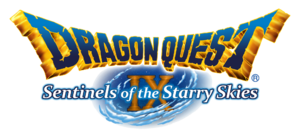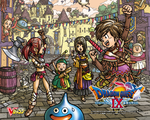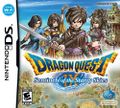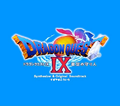Dragon Quest IX: Sentinels of the Starry Skies
| Main series games | |
|---|---|
| Sentinels of the Starry Skies | |
| Developer(s) | Level-5 |
| Publisher(s) | JP: Square Enix, NA, PAL: Nintendo |
| Designer(s) | Yuji Horii Akihiro Hino |
| Artist(s) | Akira Toriyama |
| Composer(s) | Kōichi Sugiyama |
| Series | Dragon Quest |
| Platform(s) | Nintendo DS |
| Release date(s) | JP July 11, 2009 NA July 11, 2010 EU July 23, 2010 AUS August 19, 2010 |
| Genre(s) | Role-playing game |
| Mode(s) | Single-player, multiplayer |
| Rating(s) | CERO: A |
| Media | Nintendo DS Game Card |
Dragon Quest IX (ドラゴンクエストIX 星空の守り人 Hoshizora no Mamoribito "Protectors of the Sky") is the ninth installment of the main Dragon Quest series, and the first to be initially released on a handheld console. The game was released on July 11, 2009 in Japan. It was released in July 2010 in both North America and Europe and August 2010 in Australia.
Plot[edit]
New features[edit]
Co-op Mode[edit]
Co-op mode consists of up to 4 Nintendo DS systems linking together using local wireless (similar to Pictochat) to play together. The 3 guests join the host system's world and can go anywhere which the host has explored. Guests are not required to stay with the host, but rather can wander wherever they like. Battles can be fought as a group with the host having the ability to summon the other players into a battle using the 'Call to Arms' command.
Guest players are given a special 'Watchers Wing' item which allows them to teleport back to their own world at any time except whilst in battle or cutscene. Players can leave multiplayer at any time by speaking to Pavo at Quester's Rest.
WiFi Shop[edit]
Dragon Quest IX featured an online WiFi shop which can be accessed from Quester's Rest. This shop sells items and treasure maps which the player can purchase. The contents of the shop vary each week from player to player, so 2 different players will likely have different items for sale each week. Nintendo and Square Enix have used the shop to distribute special bonuses such as party members from past games appearing as guests in the Quester's Rest, such as Carver from Dragon Quest VI, and treasure maps which lead to caves featuring past bosses, such as Zoma and Dragonlord. The WiFi shop can be accessed by talking to Sellma at Quester's Rest. The WiFi shop is the only multiplayer mode that uses WAN internet rather than the DS-to-DS wireless. The service ended on May 20, 2014, but can still be accessed by modifying DNS settings to force the DS to connect to a fan run recreation of the server.
Tag Mode[edit]
Tag Mode is Dragon Quest IX's passive wireless mode which is active only when the DS is placed into sleep mode. Tag mode is activated by speaking to Erinn at Quester's Rest and selecting the 'Canvass for guests' option. While in tag mode, Dragon Quest IX looks for other Dragon Quest IX games and exchanges data with them.
When data is exchanged, a clone of the main character from each game is placed in the other player's Quester's Rest. This cloned character holds an item which can then be received by talking to him/her. The clone then continues to stay in the upper floors of Quester's Rest unless dismissed by the player. Using tag mode like this, players can exchange various items including equipment and treasure maps with other Dragon Quest IX players.
Tag mode was wildly popular in Japan, breaking several records for most players communicating wirelessly while playing a video game. Treasure maps in particular were highly sought after as some were extremely rare with special items/equipment, while others contained excellent enemies for building levels. Tag mode, however, was dependent on the number of other Dragon Quest IX players using tag mode in any local area.
Character customization[edit]
As per Level-5's commitment, the player has an incredible degree of control when customizing characters. Several different faces, skin colours, hairstyles, can be edited by the player, as well as all weapons and armours appearing on the character model. Nearly all aspects of a character can be customized aside from their physique.
Quest system[edit]
Every town and city features citizens who need the Celestrian's help, signified by a blue icon over their head. These side missions can range from handing over specific items to defeating monsters under unusual circumstances, but always yield rich rewards for the player in exchange.
Grotto system[edit]
The aforementioned dungeons are Grottos, randomly generated areas that are based on themes such as caverns, tidal caves, and so forth. grottos are discovered by sharing treasure maps with other players and by advancing the story of the main game. These dungeons are the best way to find the most powerful gear and items available, but are also home to incredibly powerful legacy bosses and original fiends created for the game.
Expanded alchemy system[edit]
While introduced in the previous game, alchemy is greatly enhanced in IX to the degree of being a new system altogether. Countless new items have been introduced as ingredients for combinations, with several areas of the overworld dedicated to providing these materials for the player. Nearly every piece of gear either having a direct upgrade or being used as part of the recipe for a different item altogether. Due to there being no wagon, the Quester's Rest inn houses the Krak Pot, a living alchemical chamber that can instantaneously process materials into new items.
Regenerating items and treasure chests[edit]
Items found in the usual pots, dressers, bookshelves, and materials found on the overworld are now marked with a blue glimmer to gain a player's attention. These glimmers will recover once a few real world hours pass, allowing players to more easily acquire resources for alchemy.
Characters[edit]
- Hero - The Hero is a Celestrian under the tutelage of Aquila, assigned to watch over the village of Angel Falls in his/her master's stead. Later fell from the Observatory after strange beams struck through the heavens during the Fyggbloom, losing wings and halo.
- Aquila: A fellow Celestrian and mentor of the Hero. A firm but fair master, he went missing after the Hero and the Fyggs fell from the Observatory.
- Apus Major: The most senior of all the Celestrians, this all-knowing ancient rules the Observatory with a benevolent hand.
- Erinn: A young woman living with her grandfather in Angel Falls; she finds the Hero after he/she fell into the base of the waterfall. Her father was the "Inncredible Inntertainer," and Patty recruits her to help restore his old establishment, the Quester's Rest, in Stornway.
- Patty: A feisty, party girl and old acquaintance of Erinn's father. She recruits Erinn to help restore his old inn. Provides her Party Planning services for the Hero at the Quester's Rest.
- Stella: A flippant fairy keen on fashion but prone to malapropism, Stella is the skipper of the Starflight Express and has been trying to find her missing boss. Manages the Battle Records for the Hero and is always ready to give advice.
- Pavo: A Celestrian with the power to open the Rapportal. Enables the player to use multiplayer mode.
- Sellma: A representative of the Sinndicate of Pubs, Inns, and Taverns (S.P.I.T.), sent to Quester's Rest to manage the DQVC Shopping Service.
- Serena: A forlorn ghost of a woman that is wandering the Protectorate in search of someone........
- Corvus: The Guardian Of Wormwood Creek, and once Aquila's teacher. He went missing long ago under mysterious circumstances.
- Sterling: The Captain of the Starflight Express, who went missing after it was struck by a mysterious beam of light.
- Greygnarl: An ancient dragon known as the "Hero of the Heavens," he still bears wounds from when he clashed with Barbarus and the Gittish Empire. He is attended by the residents of Upover, and gets first dibs on the local ale.
- Barbarus: A dark dragon who was summoned by the Gittish Empire to do their bidding. Famously clashed with Greygnarl long ago.
- King Godwyn: A cruel tyrant from ages past who sought to bring the world under the heel of his Gittish Empire. His death was shrouded in mystery, but he and his empire seems to have returned.
- Zenus: The Grand Architect who created the world, known as simply the "Almighty" to the mortals and Celestrians.
- Celestria: The daughter of the Almighty One, she sacrificed herself and transformed herself into the World Tree Yggdrasil, until it was proven Mortals have goodness in their hearts.
Development[edit]
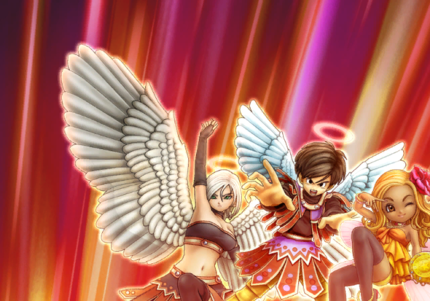
Development of IX actually began long after the preliminary stages of what would become Dragon Quest X were completed, in 2005. It was originally entering development under the assumption of being a gaiden title, or spin-off, rather than a numerical entry, but Akihiko Hino protested that the game deserved to be treated as a canon entry in the series. Hino's passion for creating a title worthy of a roman numeral led directly to the game's story being expanded enough to match the volume of previous entries: the original plan was a simple tutorial section that would then give way to the multiplayer aspect.
The desicion to produce the game for the Nintendo DS came from Yuji Horii's desire to create an RPG that friends can play together, and the handheld's ability to connect to other units merely by being in proximity eliminated the connectivity issues of stationary consoles. The DS' overwhelming popularity also contributed to the desicion, as the seventh generation of consoles paled in terms of hardware sales.
In mid-2006, Dragon Quest series composer Kōichi Sugiyama confirmed that Dragon Quest IX was in development. He is quoted by Japanese video game magazine Famitsu as saying, "I'm not sure when Dragon Quest IX will be released, but it seems that progress is continually being made. I'm personally excited." On December 12, 2006, during a press conference celebrating the 20th anniversary of the Dragon Quest franchise, Square Enix announced that Dragon Quest IX would be released exclusively for the Nintendo DS handheld video game console making it the first numbered Dragon Quest title to debut on a handheld. A demo build of the game was released to select outlets at the time, featuring battles that took place in real time as opposed to turn-based menus. This was suggested by Akihiko Hino to provide a different experience forfans, but bad reception and Yuji Horii's belief that Dragon Quest should be something that can be played by anyone regardless of skill led to the system being scrapped.
Directorial duties were split between Akihiko Hino and Jin Fujisawa, with the latter taking the lion's share of the responsibilities as Hino supervised Level-5's personal projects. Fujisawa implemented a user interface similar to that found in 'Dragon Quest Monsters: Joker', having found it to be an ideal utilization of the DS' touch screen feature. As IX's development continued in tandem with that of X, the teams shared ideas and influenced one another throught the process: the Vocation system was added to IX after it was implemented in X, and the quest system was added to the latter after being devised as a way to extend playtime in the former, to name two examples.
The Japanese release of Dragon Quest IX was subsequently delayed from 2007 to 2008. The company cited the need for more time to make a better game as reason for the delay. At the 2008 Tokyo Game Show, a new trailer was shown at the Square Enix booth which showed a glimpse of the changes made to the gameplay and graphics. At the end of the video, a confirmation of the release date (set for March 2009) was unveiled. Square Enix released another new trailer for the game, showing various aspects of the storyline, boss battles, along with cutscenes; the end of the trailer showed a then-correct release date for March 28, 2009, along with a price point of ¥5,980.
On February 12, 2009, after having delayed the release of its quarterly financials by a week, Square Enix announced the game would be delayed once again to a Japanese release on July 11 of the same year. The game's release delay worried Final Fantasy fans, who were told by Square Enix president Yoichi Wada that Dragon Quest IX's delay may affect Final Fantasy XIII's release, stating that he "[could] not say there [would not] be an effect."
Dragon Quest IX was designed to be the hardest Dragon Quest game yet. The rationale is that, according to Brian Ashcraft, Night Editor for Kotaku, the Dragon Quest IX developers say "people can always find out information on the internet — like that's part of the game experience." In addition the game has only one game slot. Ryutaro Ichimura, producer of Dragon Quest IX, clarified the reason explaining that there is not enough space on the system for multiple traditional save-slots given the amount of freedom the game allows. Instead, the save area is used for a backup save-slot in case of battery failure.
Release[edit]
Japan[edit]
Dragon Quest IX shipped with over 2 million pre-order sales. While the official release date for Dragon Quest IX was July 11, 2009, some retailers had already shipped orders; one such dealer asked its customers to not play the game until the official release date. In spite the large number of pre-orders and additional release shipments by Square-Enix, lines still formed for the release.
Within a two period the title had sold 2,318,932 copies out of an estimated 3 million copies that had been shipped. Some analyst say that 3 million may be too conservative and expect 5 million copies sold in Japan alone with large overseas sales expectations that could break previous Dragon Quest sales records. The sale is the largest post 2000 debut week sale which was previously held by the former title, Dragon Quest VIII.
North America[edit]
On July 10, 2010, one day before the official release, Dragon Quest creator Yuji Horii visited the Nintendo World Store to commemorate the release of Dragon Quest IX: Sentinels of the Starry Skies in North America at a special launch event.
The North American release of Dragon Quest IX was heavily promoted by Nintendo - the company ran commercials featuring Seth Green in theaters and on television, featured Dragon Quest IX for two weeks on Nintendo Week, and sponsored special Dragon Quest IX events at select GameStop, Best Buy, and Simon Mall locations from July 31, 2010 through August 2010 where players could obtain exclusive downloadable treasure maps. Dragon Quest IX: Sentinels of the Starry Skies was also the subject of two segments of Iwata Asks, where Satoru Iwata interviewed Yuji Horii and Ryutaro Ichimura concerning the North American release of Dragon Quest IX. Nintendo also ran a trivia contest to promote the game. The winner would receive the game early free.
The August 2010 issue of Nintendo Power also featured Dragon Quest IX on the cover.
Excluding pre-orders, Dragon Quest IX: Sentinels of the Starry Skies has been the top selling DS game in the first two weeks since its release, according to Gamasutra and Amazon.com. It was the eighth best-selling game of July 2010 in the NPD charts, with 132,000 units.
Reception[edit]
Japan[edit]
Famitsu has scored the game with 40/40, the tenth game to achieve a perfect score. After its international release, it received high reviews, including an 87% on Metacritic.com and a user score of 9.0.
Europe[edit]
In the spanish magazine Hobby Consolas the game was scored on two occasions: the first time it received 96/100 and was reviewed by a journalist of the Nintendo department, the second time it received 93/100 and it was a mix of all the reviews made by the users of the game in the website of the magazine.
Credits[edit]
| Role | Staff |
|---|---|
| Scenario & Game Design | Yuji Horii |
| Character & Monster Design | Akira Toriyama |
| Music Composer | Kōichi Sugiyama |
| Director | Akihiko Hino, Jin Fujisawa |
| Role | Staff |
|---|---|
| Chief Scenario Planner | Atsushi Narita |
| Chief Event Planner | Masahiro Kataoka |
| Scenario Staff | Fuminori Ishikawa, Takeshi Uchikawa, Kenjirou Mori, Misato Zenba |
| System Planners | Naomi Ozawa, Yoichi Kuroda |
| Event Planners | Mizuki Iizuka, Kyoko Yamazaki, Ayako Yokoyama |
| Sub Character Design | Eiichirō Nakatsu |
| Technical Support | Koji Aoyama, Hiroyuki Kikkawa |
| Role | Staff |
|---|---|
| Development Director | Ken Motomura |
| Technical Director | Yasuhiro Akasaka |
| Programming Director | Takayuki Kobayashi |
| Battle System Programming | Yukinori Yamaguchi, Kota Yamashita, Koji Chado |
| Menu Programming | Yasuhito Shibuta, Nobuhiro Ogawa |
| Scenario Programming | Takuya Nishimura |
| Network Programming | Takuya Nishimura |
| Map Programming | Atsushi Higuchi, Keiji Adachi |
| Programming Support | Mamoru Itagaki, Usuke Kumagai, Yūsuke Hashimoto, Seiji Ōta |
| Main Character Models | Shinya Hayakawa |
| Main Character Motion | Yasuyoshi Sasaki, Jun Takahata |
| Monster Models | Hiroshi Niwa, Eri Yamada |
| Monster Motion | Hiroshi Niwa, Eri Yamada |
| 3D Object Graphics | Yoshihisa Mikata, Takahiro Koshio |
| Sub-Character Design | Miho Tanaka |
| 2D Character Graphics | Noriaki Sonoda, Mitsuhito Masuo |
| Menu Design | Chikami Koori |
| Event Director | Hiroshi Matsuyama |
| Event Storyboards | Naotsugu Zushi |
| Event Scripts | Masahiro Noda, Keitaro Sato, Kyousuke Yoshioka |
| Visual Effects Director | Yoshiaki Kōya |
| Visual Effects | Mitsuhito Nakajo, Toshinori Yokoyama, Masashi Masuda, Kenichi Tanoue, Jun Itakura |
| Map Art Design Director | Takeshi Majima |
| Map Art Design | Jiro Morinaga, Masako Arakawa, Hisami Miyamoto |
| Map Graphics Director | Kazunari Matsuo |
| Map Graphics Associate Director | Ryoko Takahashi |
| Map Graphics | Akari Uchino, Nahoko Kawabata, Yoshiko Fujita, Yuko Nakano, Yūji Soga |
| Sound Effects | Dai Yamanaka, Yumiko Hashizume |
| Sound Production Support | Tomohito Nishiura |
| Special Thanks | Takehiro Fujii, Jun Sonobe, Keiji Noda, Kosuke Nagami, Yudai Oda, Takaharu Takesada, Yoshiaki Kusuda, Takahiro Fujimatsu, Kōsuke Uemura, Eiji Ishii, Takayuki Sameshima, Shigeto Suzuki, Naoko Mori, Takafumi Teraoka, Hirokazu Nagai, Akiko Shigeto, Kengo Todaka, Takuzo Nagano, Makoto Shikasho, Sayaka Mizuno, Kazuya Kuranari, Tatsuya Shinkai, Yuichi Murase, Kazunari Akita, Yuka Sonobe, Akihiro Usuki, Noriko Maruya, Yuko Warizaya, Kaoru Takahira, Moe Sudo, Yukiko Harada, Tomoko Hirayabu, Yoko Yasukochi, Chihiro Watanabe, Naoko Mizukami, Miki Murahashi |
| Test Players | Eriko Hara, Suguru Sato, Shinya Hyakuta, Jun Kirikihira, Ryosuke Miyazaki, Kenichi Kai, Ryuichi Nakagawa, Masahide Fukui, Ryo Yonemitsu, Hidetaka Kajiwara, Kenta Tomiyasu, Hiroki Fujiwara, Seiji Nishiguchi, Toshihiko Matsushita, Yui Sakamoto, Masato Nishikawa, Kosuke Mihara, Yuya Yoshida, Seiji Nakano |
| Role | Staff |
|---|---|
| Music Programming | Tose Co. Ltd. |
| Sound Advisors | Takumi Hosoyama, Hidenori Miyanaga |
| Music Programmers | Ryoue Takagi, Masaya Tsunemoto, Eri Yasuda |
| Role | Staff |
|---|---|
| Illustrations | Masuhiro Tatara & f |
| Title Logo Designs | bold Co. Ltd., Masahiko Fuchikami, Kamikazedouga |
| Animation Production | Kamikazedouga |
| Directors | Junpei Mizusaki, Toshihisa Yokoshima |
| Art Direction | Rie Suzuki |
| Movie Design | Rie Suzuki |
| Character Design | Rie Suzuki |
| Background | Tetsuro Kodama, Keita Sakai |
| Animation Director | Takanobu Mizuno |
| 3DCG | Naoto Oishi, Yuta Matsumoto, Itsune Sugiyama, Satoru Sano, Hideyuki Harano, Takayuki Abe, Mai Nakamura, Akihisa Takada, Taketo Kobayashi, Yasuyuki Watanabe, Mimu Sato |
| Key Animation | Tatsuya Shiraishi, Hiroyasu Oda |
| Title Logo Animation | Masaki Ishii |
| Supported by | wonderium Inc., DiGi Plannet Co.Ltd., Nac Inc., Sound Box Inc. |
| Production Manager | Takayuki Sasaki |
| Management | Shinya Sasahara |
| Animation Producer | Kaori Satake |
| Role | Staff |
|---|---|
| General Manager | Kazuhisa Ichigaya |
| Localisation Coordinators | Shumpei Ueyama, Simon Weisgerber, Yoshiya Hirohama |
| English Translators | Oli Chance (Shloc Ltd), Will Blatchley (Plus Alpha Translations), Clare Saracine (Plus Alpha Translations) |
| French Translators | Adeline Guichard-Lepetit, Stéphanie Malabry, Cédric Tannay, Benoît Mergault |
| Italian Translators | Massimiliano Sacchi, Irene Campisi, Lorenzo Turconi, Carmen Freschetti |
| German Translators | Georg Hund, Angela Hufschmidt, Kai Wichmann, Isabel Sterner |
| Spanish Translators | Aurora Ramírez Martínez-Esparza, Carlos Lacasa, Francesc Pedrosa |
| MSM GmbH Localisation Management | Dirk Sander, Andrea Schröter |
| Special Thanks | Reika Osada, Mari Kojima |
| Role | Staff |
|---|---|
| Coordinators | Toshihiro Takemoto, Makiko Nakai, Kento Yokota, Minami Maruyama, Hiroshi Kondo |
| Technical Engineers | Tomohito Kohno, Toshimitsu Umezawa, Toyokazu Takehara, Akihiko Nagayama, Tadahiro Kaneko, Shinya Tsukioka, Masakazu Kawanishi, Haruka Suzuki |
| Testers | Shinji Hirokawa, Toyokazu Takagi, Kazuhiko Yamaguchi, Susumu Kurihara, Kenji Nishikawa, Akitoshi Yukawa, Katsuya Aiso, Daigoro Yoshino, Youhei Shimabayashi, Kana Yokoyama, Miki Yamaguchi, Momoko Tanaka, Hiroki Satō, Mari Yamazaki, Masahiro Eguchi, Kei Tamura, ...and the entire QA staff |
| Chief Coordinator | Yuuchi Kikumoto |
| Ratings Advisors | Sueko Kogai, Reiko Kondo |
| Manager | Hideyuki Kato |
| Senior Manager | Yukihiro Shibuya |
| General Manager | Koji Yamashita |
| Role | Staff |
|---|---|
| Corporate Executive | Koji Taguchi |
| Original Publicity Producer | Minako Gotō |
| Original Publicity Team | Noriko Ozaki, Itsuko Katano |
| Role | Staff |
|---|---|
| Public Relations Director | Ryoichi Kuramochi |
| Public Relations Assistant | Mayumi Takita |
| Dragon Quest Team | Taichi Inuzuka, Yoshiki Watabe, Noriyoshi Fujimoto, Kaito Yamaguchi, Hiroshi Satō, Chikako Sato, Ryota Aomi |
| Role | Staff |
|---|---|
| Senior Quality Assurance Manager | David Carrillo (Ribs) |
| Assistant QA Manager | Aaron J. Adams |
| Senior QA Coordinator | Mathew A. Clift |
| QA Coordinator | Jeremy G. F. Goldsmith |
| Assistant QA Coordinator | John Clark |
| QA Adiminstrator | Keith P. Martz |
| QA Associate | Joshua D. Boden |
| QA Team | Tim Blake, Teresa Curry, Amber Elliott, Matthew Fieler, Eddie Kim, Kristina Lee, Matthew Lee, Jesse Blake McCann, Stefanie Okumura, Victoria Oliver, Erika Rodriguez, Stephen Neil Valdez |
| QA Translator | Takahiro Soh |
| Localisation Director | Yutaka Sano |
| QA Director | Yutaka Sano |
| President | John Yamamoto |
| CEO | John Yamamoto |
| Role | Staff |
|---|---|
| Chief of QA | André Woitczyk |
| Assistant QA Managers | Lee Deneini, Dario de Cesare |
| UK QA Co-ordinator | Vince Sri-Ram |
| UK QA Lead | Alex Chinchen |
| UK QA Team | Helen Gray, Shailesh Iyer, Haren Patel, Ikechi Emeruwa |
| French QA Co-ordinator | Thibaut Salembier |
| French QA Lead | Kevin Balon |
| French QA Team | Élodie Anger, Florian Genthon, Bruno Vala, Fabian Weber, Johan Wyckaert |
| Italian QA Co-ordinator | Gaetano Fabozzi |
| Italian QA Lead | Giulia Isnenghi |
| Italian QA Team | Massimiliano Bonatto, Nelson Cerino, Simone Della Fornace, Diego D'Alessandro, Enrico Sette |
| German QA Co-ordinator | Hoi-yee Leung |
| German QA Lead | Michael Becker |
| German QA Team | Jana Beck, Juliane Hackbarth, Julia Lotzow, Soleiman Mohsseni, Angela Schattner, Christian Wolf |
| Spanish QA Co-ordinator | Píndaro Vargas-Farías |
| Spanish QA Lead | Carlos Montoya Lara |
| Spanish QA Team | Vanessa Góngora Jurado, Héctor Lorda Ruiz, Pablo Menéndez Pérez, Patricia Pérez Vera, Marta Torrus Pons |
| Localisation Team | Pierre Gauthier, Elisa Giribaldi, Sina Moelleken, Mariona Pera i de Miguel, Morgan Rushton |
| Localisation Producer | Alessandro Bovenzi |
| Assistant Localisation Producer | Daniel Mellar |
| Assistant Production Manager | Yuko Tomizawa |
| Senior Production Manager | Sebastian Ohsan Berthelsen |
| Senior Creative Services Manager | Stéphanie Journau |
| Assistant Brand Manager | Craig Parker-Wood |
| Senior Brand Manager | Adrian Arnese |
| European PR Manager | Alex Huhtala |
| Brand Director | Makoto Kotaka |
| Project Co-ordination | Makoto Kotaka |
| Digital Communcations Manager | Antonio Marfuggi |
| Vice-President | Larry Sparks |
| Co-OOs | Michael Sherlock, Jürgen Goeldner |
| President | Phil Rogers |
| CEO | Phil Rogers |
| Role | Staff |
|---|---|
| Coordination | Yutaka Takehisa, Sakae Yamazaki |
| Role | Staff |
|---|---|
| Coordination | Jeff Miller, William Trinen, Chiko Bird, Robert Heiret |
| Role | Staff |
|---|---|
| Coordination | Takashi Ebiike, Michaël Hugot, Alexandra Potter |
| Role | Staff |
|---|---|
| Special Thanks from Square Enix | Sugiyama Kobo, Shueisha Inc., Nintendo Co. Ltd., Kaori Okada, Kazumi Hisada |
| Publishers | Yōichi Wada, Keiji Honda |
| General Producer | Yukinobu Chida |
| Executive Producer | Yū Miyake |
| Assistant Producer | Shuhei Yamaguchi |
| Producer | Ryutaro Ichimura |
Gallery[edit]
External links[edit]
- Official Dragon Quest IX Japanese Website
- Teaser Site The Official Dragon Quest IX Teaser Website from Level 5
- Dragon Quest IX at IGN.
